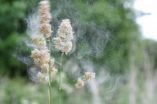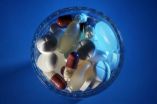(Press-News.org) For the first time researchers have succeeded in altering HIV virus particles so that they can simultaneously, as it were, 'cut and paste' in our genome via biological processes. Developed at the Department of Biomedicine at Aarhus University, the technology makes it possible to repair genomes in a new way. It also offers good perspectives for individual treatment of both hereditary diseases and certain viral infections:
"Now we can simultaneously cut out the part of the genome that is broken in sick cells, and patch the gap that arises in the genetic information which we have removed from the genome. The new aspect here is that we can bring the scissors and the patch together in the HIV particles in a fashion that no one else has done before," says associate professor in genetics Jacob Giehm Mikkelsen from Aarhus University.
'Hit-and-run' technique leaves no traces
At the same time, the team of researchers from Aarhus have developed a technique that increases the safety of the cutting process, the so-called "gene editing":
"In the past, the gene for the scissors has been transferred to the cells, which is dangerous because the cell keeps on producing scissors which can start cutting uncontrollably. But because we make the scissors in the form of a protein, they only cut for a few hours, after which they are broken down. And we ensure that the virus particle also brings along a small piece of genetic material to patch the hole," says Jacob Giehm Mikkelsen.
"We call this a 'hit-and-run' technique because the process is fast and leaves no traces".
Viruses become nanoparticles
The researchers have benefited from many years of intense research into HIV as this has e.g. shown that HIV particles can be converted into transporters of genetic information. But when they also become transporters of proteins that are not normally found in the cells, as is the case now, the particles are altered. Virus particles are converted into nanoparticles which carry the substances that can have a direct effect on the treated cells.
HIV infection is one of the areas where the researchers want to make use of the technique, and here the goal is to stop a specific gene from functioning - something that the protein scissors can do.
"By altering relevant cells in the immune system (T cells) we can make them resistant to HIV infection and perhaps even at the same time also equip them with genes that help fight HIV.
"So in this way HIV can in time become a tool in the fight against HIV," says postdoc and PhD Yujia Cai of the research team.
The results have recently been published in the scientific journal eLIFE.
INFORMATION:
Facts:
"Gene editing" is surgery in genomes. You cut a hole in the genome and help the cell to repair genetic defects in the vicinity of the location where the scissors cut.
The "scissors" in the manipulated virus particles, which are also called 'designer nucleases", are the proteins that the researchers have equipped the particles with so they can cut the DNA.
"The patch" is the genetic information that will replace the information in the genome.
HIV can cut and paste in the human genome
Aarhus University has developed a technology that uses the HIV virus as a tool in the fight against hereditary diseases
2014-05-27
ELSE PRESS RELEASES FROM THIS DATE:
'Virtual human' shows that stiff arteries can explain the cause of high blood pressure
2014-05-27
High blood pressure is highly age-related and affects more than 1 billion people worldwide. But doctors can't fully explain the cause of 90 per cent of all cases. A computer model of a "virtual human" suggests that stiff arteries alone are enough to cause high blood pressure.
"Our results suggest that arterial stiffness represents a major therapeutic target. This is contrary to existing models, which typically explain high blood pressure in terms of defective kidney function," says Klas Pettersen, a researcher at the Norwegian University of Life Sciences and first author ...
Why does bacon smell so good? (video)
2014-05-27
WASHINGTON, May 27, 2014 — We all know bacon is delicious, but what is it about cooking bacon that makes it smell so tantalizing? In the American Chemical Society's (ACS') latest Reactions video, the team puts its nose into everyone's favorite breakfast food. We collaborated with the Compound Interest blog to break down the science of that sweet smell. The video is available at http://youtu.be/2P_0HGRWgXw
Subscribe to the series at Reactions YouTube, and follow us on Twitter @ACSreactions to be the first to see our latest videos.
INFORMATION:
The American Chemical ...
Scientists map the worst times of day for people allergic to grass pollen
2014-05-27
Atishoo! Help, there are flowering grasses around, please stay indoors – while your friends enjoy the nice summer weather! Traditionally, people allergic to grass pollen are advised to be aware of high pollen concentrations during the day, and to reduce their outdoor activities during this period.
A new study led by researchers from Aarhus University shows that it is considerably more complicated to avoid grass pollen. Based on a three-year study with intensive measurements at three different locations in Aarhus, they divide the grass pollen season into three periods, ...
Sperm cells are extremely efficient at swimming against a current
2014-05-27
Like salmon traveling upstream to spawn, sperm cells are extremely efficient at swimming against the current, according to research to be published this week.
The discovery, to be published in the journal eLife by researchers at MIT and Cambridge University, may help us to understand how some sperm travel such long distances, through difficult terrain, to reach and fertilize an egg.
Of the hundreds of millions of sperm cells that begin the journey up the oviducts, only a few hardy travelers will ever reach their destination. Not only do the cells have to swim in the ...
Attack is not always the best defense
2014-05-27
Jena (Germany) It is something like the police force of our body: the immune system. It disables intruding pathogens, it dismantles injured tissue and boosts wound healing. In this form of 'self-defense' inflammatory reactions play a decisive role. But sometimes the body's defense mechanism gets out of control and cells or tissues are affected: "Then excessive reactions can occur and illnesses along with them," Prof. Dr. Oliver Werz of the Friedrich Schiller University Jena says. He gives asthma, rheumatism, arteriosclerosis and cancer as examples: "For many of these diseases ...
The secret cargo of mosquitoes
2014-05-27
The parasite Dirofilaria repens is a roundworm that primarily attacks the subcutaneous tissue of dogs and causes lumps in the skin, swelling, and itching. Dogs, cats, foxes, wolves and martens can be infected in addition to dogs. "In humans, 16 cases of human dirofilariosis have been recorded since the year 2000, but the dark figure is definitely higher", says the lead author Katja Silbermayr. Humans, however, are so-called dead end hosts; the parasite does not reproduce in humans and therefore poses no major risk.
Silbermayr is a veterinarian and performs research on ...
Seeing e-cigarette use encourages young adult tobacco users to light up
2014-05-27
VIDEO:
"Whether participants were exposed to someone smoking a combustible or an e-cigarette, the urge to smoke a combustible cigarette was just as high in either condition, " King said. "If the...
Click here for more information.
Seeing people use electronic cigarettes (e-cigarettes) increases the urge to smoke among regular combustible cigarettes users, according to a new study of young adult smokers. This elevated desire is as strong as when observing someone ...
Stanford researchers discover immune system's rules of engagement
2014-05-27
A study led by researchers at Stanford's School of Medicine reveals how T cells, the immune system's foot soldiers, respond to an enormous number of potential health threats.
X-ray studies at the Department of Energy's SLAC National Accelerator Laboratory, combined with Stanford biological studies and computational analysis, revealed remarkable similarities in the structure of binding sites, which allow a given T cell to recognize many different invaders that provoke an immune response.
The research demonstrates a faster, more reliable way to identify large numbers ...
Climate change accelerates hybridization between native and invasive species of trout
2014-05-27
BOZEMAN, Mont. – Scientists have discovered that the rapid spread of hybridization between a native species and an invasive species of trout in the wild is strongly linked to changes in climate.
In the study, stream temperature warming over the past several decades and decreases in spring flow over the same time period contributed to the spread of hybridization between native westslope cutthroat trout and introduced rainbow trout – the world's most widely introduced invasive fish species –across the Flathead River system in Montana and British Columbia, Canada.
Experts ...
New perspectives to the design of molecular cages
2014-05-27
Researchers from the University of Jyväskylä report a new method of building molecular cages. The method involves the exploitation of intermolecular steric effects to control the outcome of a self-assembly reaction.
Molecular cages are composed of organic molecules (ligands) which are bound to metal ions during a self-assembly process. Depending on the prevailing conditions, self-assembly processes urge to maximize the symmetry of the system and thus occupy every required metal binding site. The research group led by docent Manu Lahtinen (University of Jyväskylä, Department ...
LAST 30 PRESS RELEASES:
New expert guidance urges caution before surgery for patients with treatment-resistant constipation
Solar hydrogen can now be produced efficiently without the scarce metal platinum
Sleeping in on weekends may help boost teens’ mental health
Study: Teens use cellphones for an hour a day at school
After more than two years of war, Palestinian children are hungry, denied education and “like the living dead”
The untold story of life with Prader-Willi syndrome - according to the siblings who live it
How the parasite that ‘gave up sex’ found more hosts – and why its victory won’t last
When is it time to jump? The boiling frog problem of AI use in physics education
Twitter data reveals partisan divide in understanding why pollen season's getting worse
AI is quick but risky for updating old software
Revolutionizing biosecurity: new multi-omics framework to transform invasive species management
From ancient herb to modern medicine: new review unveils the multi-targeted healing potential of Borago officinalis
Building a global scientific community: Biological Diversity Journal announces dual recruitment of Editorial Board and Youth Editorial Board members
Microbes that break down antibiotics help protect ecosystems under drug pollution
Smart biochar that remembers pollutants offers a new way to clean water and recycle biomass
Rice genes matter more than domestication in shaping plant microbiomes
Ticking time bomb: Some farmers report as many as 70 tick encounters over a 6-month period
Turning garden and crop waste into plastics
Scientists discover ‘platypus galaxies’ in the early universe
Seeing thyroid cancer in a new light: when AI meets label-free imaging in the operating room
Neutrophil-to-lymphocyte ratio may aid risk stratification in depressive disorder
2026 Seismological Society of America Annual Meeting
AI-powered ECG analysis offers promising path for early detection of chronic obstructive pulmonary disease, says Mount Sinai researchers
GIMM uncovers flaws in lab-grown heart cells and paves the way for improved treatments
Cracking the evolutionary code of sleep
Medications could help the aging brain cope with surgery, memory impairment
Back pain linked to worse sleep years later in men over 65, according to study
CDC urges ‘shared decision-making’ on some childhood vaccines; many unclear about what that means
New research finds that an ‘equal treatment’ approach to economic opportunity advertising can backfire
Researchers create shape-shifting, self-navigating microparticles
[Press-News.org] HIV can cut and paste in the human genomeAarhus University has developed a technology that uses the HIV virus as a tool in the fight against hereditary diseases





